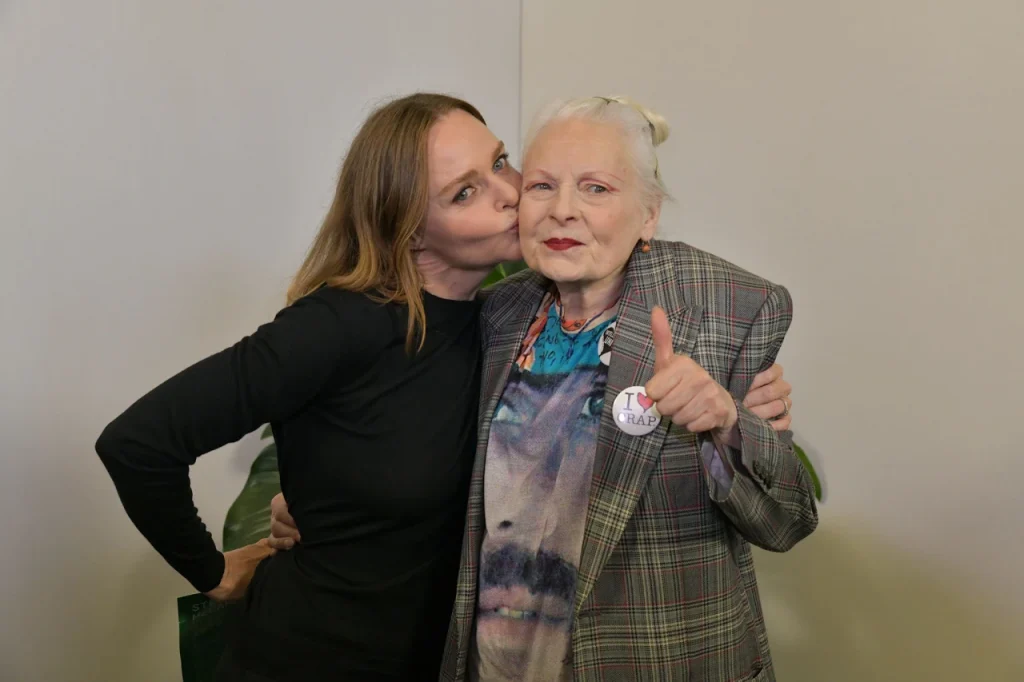
British Fashion Royalty Stella McCartney and Vivienne Westwood. (Photo Credit: WWD.)
Long before Women’s History Month was put into motion in 1981, female fashion designers were paving their own path, empowering women by providing women fashion options that instilled confidence, helped build careers so that they could support themselves and their families. While many associate fashion with style, these creative geniuses have used their talents to foster an individualistic path to self-expression and to alter old-fashion notions of what a woman ‘should be’. Can you name even one female friend of yours who aspires to be like June Cleaver from the TV series Leave it to Beaver?
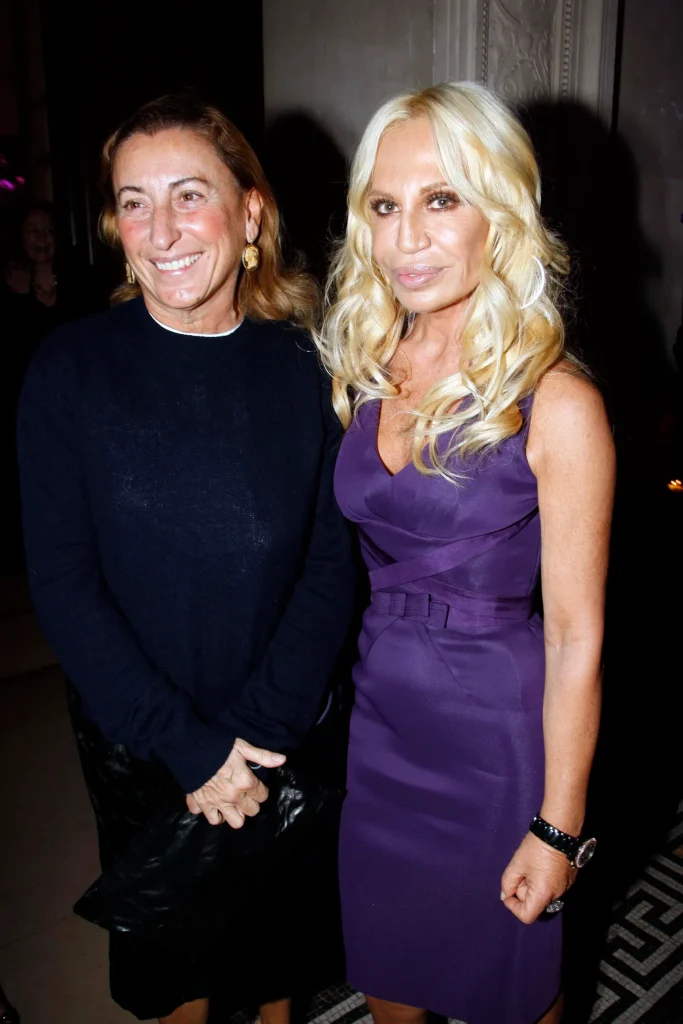
Female Italian powerhouses Miuccia Prada and Donatella Versace. (Photo Credit: Getty Images)
This year, due to so many female caregivers and frontline workers who have worked tirelessly through the global pandemic, the 2022 Women’s History theme is, “Providing Healing, Promoting Hope,” and is a tribute to the thousands of ways that women of all cultures have provided both healing and hope throughout history.
As we celebrate Woman’s History Month, UoF is exploring some of the most influential female designers today who continue to make an impact not only in fashion but in the world.
MIUCCIA PRADA
CREATIVE DIRECTOR AT PRADA & MIU MIU
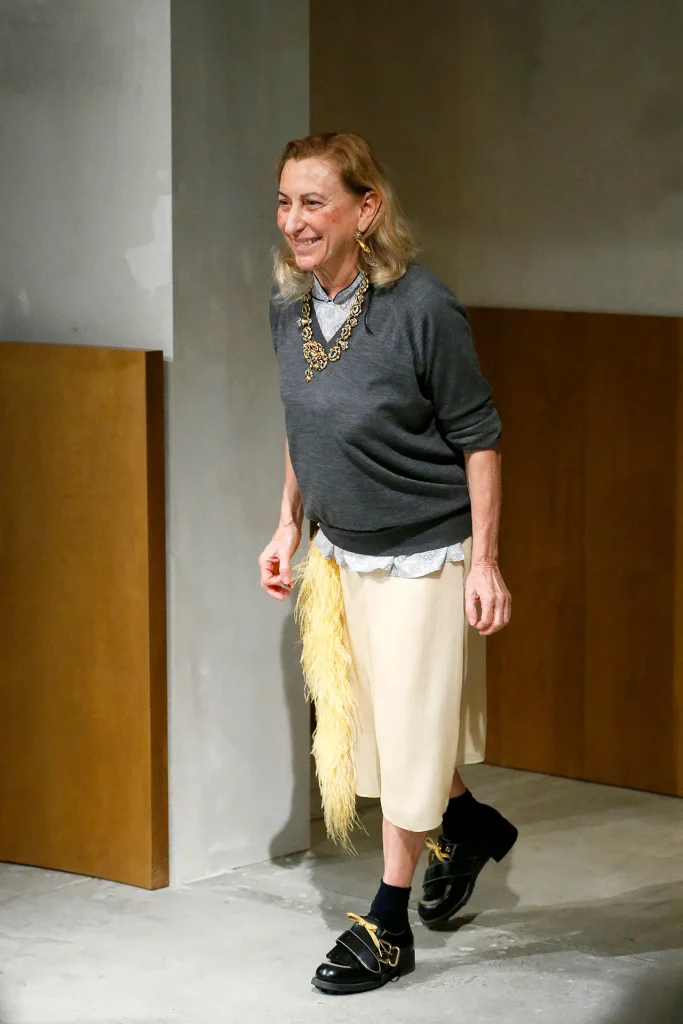
A photo of Miuccia Prada. (Photo Credit: Getty Images)
As a young woman, Miuccia Prada did not dream of a career in fashion. The iconic designer, originally named Maria Bianchi, studied political science and graduated with a PhD from the University of Milan. As part of the Italian Communist Party in the Sixties, Prada is quoted in a Document Journal, “Fashion was the worst place for a feminist in the ’60s.” Thankfully she couldn’t ignore her calling and talent to pursue a career in fashion, and by 1979, she joined the family business.
In 1989, Prada launched her first woman’s ready-to-wear collection, and by the early ‘90s every fashionistas saved their pennies to purchase anything that Prada created. She forever changed fashion. With a swift pivot of her chunky heeled loafer, women everywhere threw their teetering stilettos in the back of their closets, and the “ugly shoe” trend began. For her Spring 1996 collection, Prada transformed ‘ugly’ into the most fashionable and sought after looks, from upholstery prints to putrid, acid colors to square-toed, T-strap shoes. By Ms. Prada’s own admission in an interview with Vogue magazine, “Ugly is attractive, ugly is exciting. Maybe because it is newer. The investigation of ugliness is, to me, more interesting than the bourgeois idea of beauty.”
Throughout the years, Prada has stuck to the DNA of the brand she created. Prada’s “ugly prints” range from geometric prints, lip motifs, and even an ode to Frankenstein, but somehow, she makes it all so desirable. Prada continues to find countless ways to render what is traditionally considered unconventional, attractive. For example, designer has paired midi skirts with lug-soled brogues. She has clashed babydoll tops with board shorts. She has advocated socks with sandals, nubby wool tights, and body-concealing nylon puffas, while simultaneously creating sexy little scarf dresses, miniskirts with trains, and naughty frocks with pointed busts.
Her history as a feminist fighter still shines through in her collections, something that’s obvious in the lack of traditionally sexy pieces. Prada designs intellectual pieces for both her Prada and Miu Miu labels, and her focus is always on what women want and need. “I want to be more clever, or more difficult, or more complicated, or more interesting, or more new,” she says to Document Journal.
DONATELLA VERSACE
CREATIVE DIRECTOR AT VERSACE

Leave it to Donatella Versace to create a golden supermodel moment. (Photo Credit: Shutterstock)
On the opposite side of the Prada spectrum is Donatella Versace, another strong, Italian female designer, who has changed the way women and men around the world dress.
Donatella Versace is known for her platinum blond hair, sun-kissed skin, teetering platform heels, and sexy, second-skin clothing. The designer is having a major moment as Gen Z is obsessed with the ‘90s, and Versace’s golden-tinted fantasyland. Sadly, Donatella’s iconhood was, in fact, created out of tragedy, following the murder of her brother Gianni (the founder of the house) in 1997.
Gianni Versace’s shocking murder was a huge lose to the world. His bold approach to fashion with loud colors, ostentatious prints, and plenty of sex appeal was epic and up until his death, Gianni and his sister Donatella were always in the fashion limelight. Their zest for life was translated into each collection and every supermodel in the ‘90s wanted to walk Versace’s show.
Donatella had always worked closely with Gianni and was instrumental in forging the house’s heritage status. Donatella was more than Gianni’s muse, she worked tirelessly promoting the brand and was responsible for creating the relationships between the house of Versace and all the rockstars and rappers who loved the label. Donatella amped up the celebrity quotient at the Versace front row and was friends with all the supermodels at the time: Linda Evangelista, Christy Turlington, Naomi Campbell, and Cindy Crawford – to name a few.
Once Gianni passed away, Donatella took the reins of the house and became creative director for the brand. But the Italian rockstar and non-stop party girl lifestyle took a toll on her. According to Vogue Magazine, “she was one of the first in fashion to find redemption in rehab and yet not suffer public vilification for it. This, too, has contributed to giving her iconography a human and vulnerable aspect. Donatella, the survivor.”
MARIA GRAZIA CHIURI
CREATIVE DIRECTOR OF WOMENSWEAR FOR DIOR
A photo of Maria Grazia Chiuri, Creative Director for Dior’s Women’s Collection. (Photo Credit: Jean-Paul Goude)
Maria Grazia Chiuri rose to fame in 2007 when she became co-creative director of Valentino alongside Pierpaolo Piccioli, her design partner for 26 years. Then, in July of 2016, she went out on her own and was also hired as the creative director of womenswear for the legendary house of Dior. Chiuri became the first-ever female to take on such a prestigious role at the storied house.
Thanks to Chiuri, the brand reinstated its iconic Saddle bag, which has been spotted on countless celebrities and fashion enthusiasts since its return in 2018. Under Chiuri’s leadership, the French house saw a 44% increase in sales in 2021.
Chiuri is an active feminist, and her designs reflect the sociological environment that we live in today. For her debut collection at Dior Spring 2017, she featured message tees that boldly stated, pre-#MeToo, “we should all be feminists,” a literal reference to the writing of Chimamanda Ngozi Adichie and a sartorial nod to another female design pioneer Katharine Hamnett. Chiuri mixed these tees with a nod to fencers and ballerinas and a new Dior woman materialized: strong yet delicate, with a fighting spirit and a desire for romance.
For her spring ‘18 collection, Chiuri was inspired by Linda Nochlin’s 1971 essay “Why Have There Been No Great Women Artists?” handing out copies of the essay and printing its title on T-shirts. For her spring ’20 collection, Chiuri gave a nod to goddesses throughout history, in front of a backdrop that read, “What If Women Ruled The World?”
The designer’s efforts surrounding gender equality have been noticed and taken seriously. In fact, she received the Legion of Honor, France’s highest civilian distinction, from the country’s gender equality minister Marlène Shiappa in 2019.
REI KAWAKUBO
CREATIVE DIRECTOR AT COMME DES GARÇONS
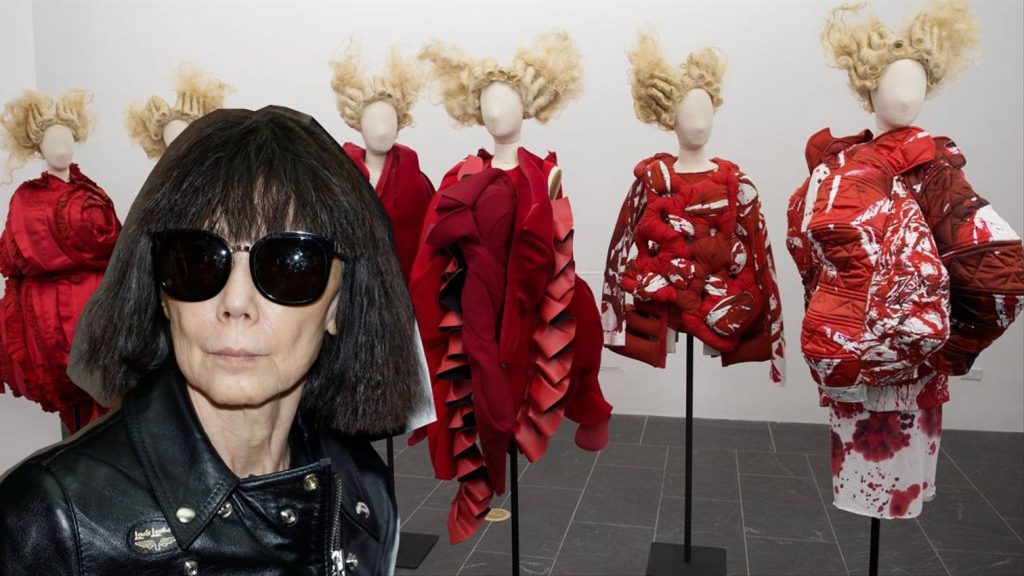
A photo of Rei Kawakubo and looks from her MET Exhibit. (Photo Credit: MTV News)
“I work in three shades of black,” Comme des Garçons founder Rei Kawakubo once said, but the throngs of women who have been captivated and inspired by her clothes might beg to differ—she utilizes far more variations of black than a measly three. The revolutionary Kawakubo has been creating avant-garde fashion for over a half century. The elusive designer has been, and still is, hell-bent on toppling conventional ideas of attractiveness, arguing, “for something to be beautiful it doesn’t have to be pretty.… Comme des Garçons is a gift to oneself, not something to appeal or to attract the opposite sex.” (A rare statement Kawakubo has made on record to Vogue Magazine).
The press nicknamed her customers “the crows”, as they are draped in their voluminous deconstructed Comme des Garçons fashions. But her artsy clients understand the true freedom in wearing Kawakubo’s unique designs. Kawakubo is known for her dramatic designs from her “added lump” collection to her flattened “paper doll” looks. Often Kawakubo uses polyester, leaves seams frayed, and blurs the line between masculine and feminine clichés.
In 2017, the Metropolitan Museum of Art in New York City celebrated Kawakubo with an exhibition entitled, “Rei Kawakubo/Comme des Garçons, Art of the In-Between.” The show was designed as an austere, all-white maze and presented approximately 150 Comme des Garçons creations. Andrew Bolton, the curator for the Met show, stated: “I really think her influence is so huge, but sometimes it’s subtle.… It’s the purity of her vision.”
SARAH BURTON
CREATIVE DIRECTOR AT ALEXANDER MCQUEEN

A photo of Sarah Burton, in her studio at Alexander McQueen. (Photo Credit: David Burton)
Another rise to fame came from another tragedy. On February 11, 2010, Lee McQueen, the creative director, and founder of the brand Alexander McQueen, committed suicide, leaving the fashion industry shook to its core. Two months later Sarah Burton was named Lee McQueen’s successor. Burton, who had been working with McQueen since 1996, first as an intern, then as his personal assistant, rose to head of womenswear in 2000, so it was a natural progression for her to replace McQueen.
Through the years since McQueen’s death, Burton stayed true to the brands aesthetic and has been a diligent guardian of the McQueen flame, but… she has also enhanced it. Under Burton’s leadership, many of McQueen’s signature elements —the beautifully dramatic but also the painfully dark juxtaposition that were part of McQueen’s inner demons (that he could not let go of), have been transformed into less radical and significantly more femicentric.
On April 29, 2011, Burton and her label became a household name as she was commissioned to dress Catherine Middleton, The Duchess of Cambridge, for her wedding to Prince William. The world watched the extravagant wedding and Middleton looked like the perfect princess in every way. Burton created a silk satin gown, tapestried by the Royal School of Needlework, which was a key moment in her new chapter at the house.
Burton’s runway shows are always theatrical, in keeping true to the house’s DNA. Burton told Vogue Runway in an interview: “Lee always said to me, “You have to make things your own, you have to believe in it, and it has to be an emotional thing, what we do.” She has achieved the perfect balance between her creativity and Lee McQueen’s vision, he would be proud.
STELLA McCARTNEY
CREATIVE DIRECTOR AND FOUNDER OF STELLA McCARTNEY
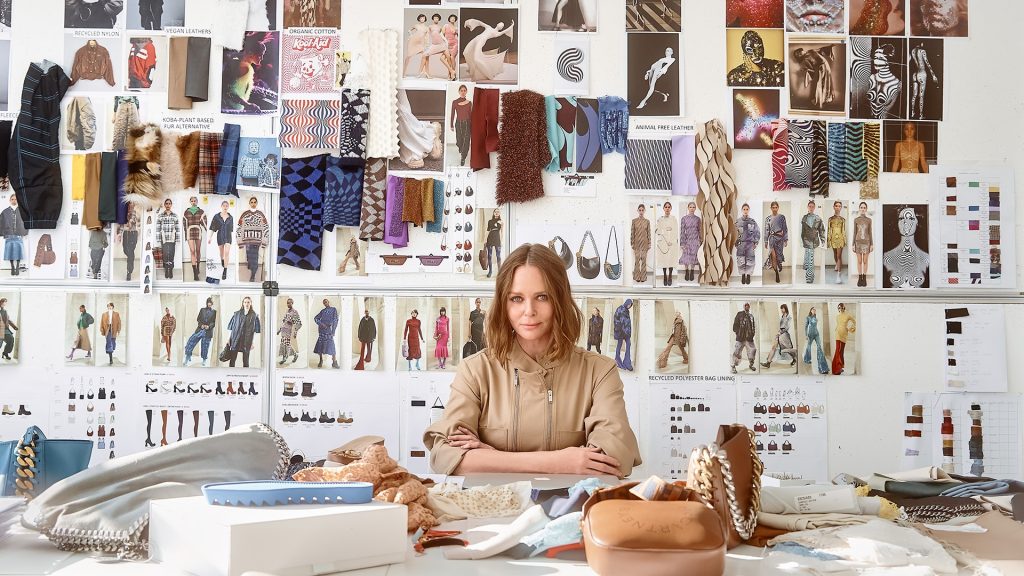
Stella McCartney in her London Studio. (Photo Credit: Jules Esick)
Stella McCartney has been the fashion industry’s conscience for decades. As a leading advocate for sustainability in fashion, she has been a pioneer to reduce the carbon footprint of her namesake collection. For McCartney, sustainability is not a gimmick or a one season effort, she’s been championing the movement before it was the “thing to do,” and she practices what she preaches every season. No green-washing here.
Always ahead of a movement, McCartney debuted her fur and leather free collection in 2001 and faced plenty of criticism: How could a designer possibly build a business without luxury leather goods? Her now-signature Falabella bag proved precisely how. For McCartney’s fall ‘20 collection, the designer sent models dressed as animals down the runway, followed by an Instagram campaign featuring cartoons of animals expressing things like, “My coat looks better on me” and “What the fox?? I’m not fashion.” The collection was cruelty free.
Fast forward to today. McCartney is not only known for her signature non-leather goods and her playful, sporty ready-to-wear, but she’s inspiring a generation of women to think about the environmental impact of what they buy. McCartney believes that fashion shouldn’t just be about how we look; it should be about how our choices relate to the environment and people around us.
In addition to her sustainability efforts, McCartney is also known for her very British and feminine design aesthetic, so much so that she was selected to design the dress Meghan Markle wore to the Royal Wedding reception (which was made of viscose, a fluid material made from wood pulp). Apart from the obvious reasons for accepting the design gig, McCartney said she designed the dress for Markle because she’s “a women’s woman,” according to Harper’s Bazaar UK.
McCartney is not only a successful designer, but she is also a true environmental activist. In a past campaign, she enlisted women from the climate activist group Extinction Rebellion, and she’s still the only designer who has encouraged people to consign their used designer items through the commerce site, The RealReal. In a Vogue.com story, she spoke candidly about the lack of progress from her designer peers: “I just think it’s time to man up and have an element of honesty. I do need a few more colleagues linking my arm and standing shoulder to shoulder with me, because that’s how we can make significant change.”
VIVIENNE WESTWOOD
FOUNDER AND DESIGNER AT VIVIENNE WESTWOOD
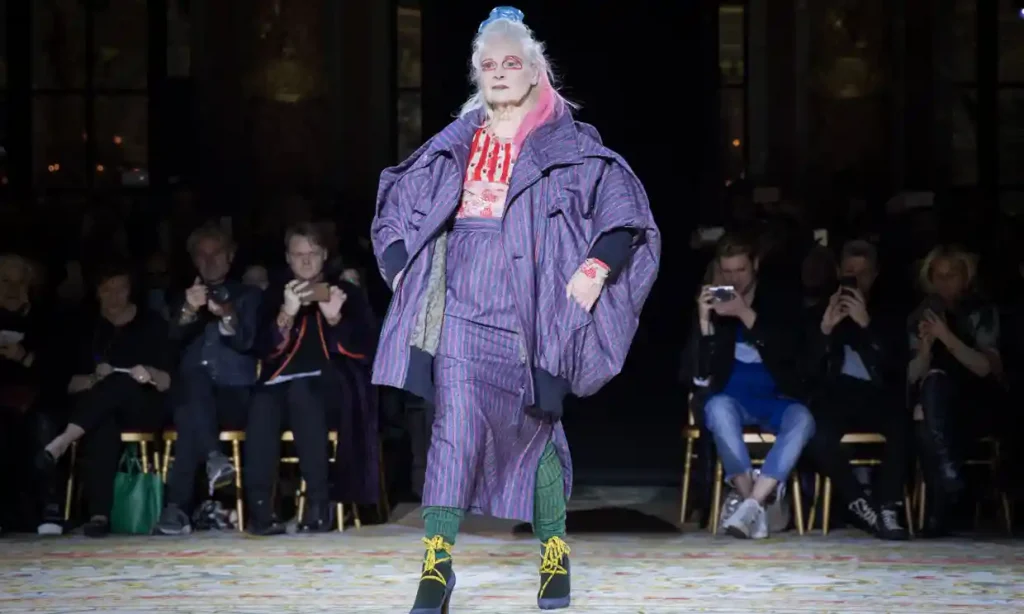
Vivienne Westwood modelling in her own show. (Photo Credit: Getty Images)
Since arriving in London in the late 1960s, Vivienne Westwood has captured the many ways women express themselves through fashion—and her collections have often been as cheeky, controversial, and surprising as their creator.
Westwood exploded onto the fashion world when she teamed up with Sex Pistols manager Malcolm McLaren, and together they launched the garments that the world would come to know as punk: “… punk fashion itself was iconographic: rips and dirt, safety pins, zips, slogans, and hairstyles,” she once declared. But Westwood is far from a one-trick-pony, while the creative designer still has many elements of punk within her collection, she also offers clothes that rely on brilliant tailoring made their rebellious points—collections with names like Savages (1981), Buffalo/Nostalgia Of Mud (1982), Punkature (1982), and Worlds End (1984). Successive shows went on to channel young romantics, which offered a twisted homage to the mini-crinis of Christian Lacroix.
For almost a half of a century Westwood dressed generations of women with chic yet rebellious clothes, and even today, Westwood hasn’t lost her ‘punish’ charm.
In 1992, Vivienne Westwood was awarded an OBE (the British Empire award, it is the second highest ranking Order of the British Empire award). Westwood arrived at Buckingham Palace knicker-less, a decision documented by a photographer in the palace courtyard. Westwood later said, “I wished to show off my outfit by twirling the skirt. It did not occur to me that, as the photographers were practically on their knees, the result would be more glamorous than I expected.… I have heard that the picture amused the Queen.”
A true rebel through and through.
DIANE VON FURSTENBERG
FOUNDER AND DESIGNER OF DIANE VON FURSTENBERG

Diane Von Furstengerg in her iconic dress on the cover of Newsweek in 1976. (Photo Credit: Newsweek)
Not many designers are as closely associated with a single garment as Diane von Furstenberg is with the wrap dress. A staple in every woman’s wardrobe, von Furstenberg introduced her iconic dress in 1974. The socialite and former princess came up with the idea when she separated from her then-husband Prince Egon von Furstenberg and wanted something that felt modern and independent, something that was the complete opposite from her former socialite wardrobe. “Usually, the fairytale ends with the girl marrying the prince,” she said in a 2012 issue of British Vogue. “But mine started as soon as the marriage was over.”
The DVF wrap jersey number was more than a dress: It was a quiet feminist symbol. Although women were not familiar with von Furstenberg’s story when she first introduced the wrap dress, they quickly became fans of the dress’s slinky ease and vibrant prints. By 1976, von Furstenberg was selling 25,000 of them a week. DVF’s signature dress was copied by many, and suddenly wrap dresses were everywhere, von Furstenberg’s business experienced a significant lull—but unlike many of her fellow designers, she weathered the storm and made a successful comeback in the early 2000s.
In 2006, the glamourous von Furstenberg was named president of the Council of Fashion Designers of America, a position she held until 2019 when she passed the baton to Tom Ford. Von Furstenberg’s wrap dresses are still selling successfully. Through the years, she experimented with a variety of silhouettes and avant-garde prints, but on the verge of fifty years in business, von Furstenberg’s going back to her roots: clothes with simplicity, ease, and a joyful spirit. “If I have made any contribution, I want it to be that we were the friend in the closet,” she said in a past interview with Vogue Magazine. “We serve women’s needs.”
There are so many other influential female designers in the world today, can you tell us, who are your favorites?
-------------------------------------
By: Antonia Sardone
Title: CELEBRATING WOMEN’S HISTORY MONTH: FEMALE DESIGNERS WHO ARE INFLUENCING FASHION
Sourced From: www.universityoffashion.com/blog/celebrating-womens-history-month-female-designers-who-are-influencing-fashion/
Published Date: Sun, 20 Mar 2022 23:55:27 +0000
Read More
 FestivalsMusicNew ReleasesArtistsFashion & ClothingVideosPrivacy PolicyTerms And Conditions
FestivalsMusicNew ReleasesArtistsFashion & ClothingVideosPrivacy PolicyTerms And Conditions
